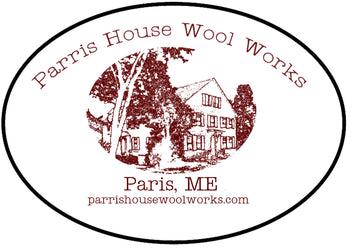Yet Another Addictive Aspect of Rug Hooking
 |
| My first wools, a selection of solid primitive colors, finished and stacked.. |
I thought for those of you who have not yet tried this, I would use this post to explain the basic process, but more importantly, to allay any and all fear or anxiety you may have about trying it. I was very nervous - I thought there had to be some magic involved or some skill I could not possibly possess, but just as my hooking teacher had promised, it really IS easy!
I began by going to a local wool supplier we are fortunate to have in my area of Maine, the Oxford Mill End Store, and choosing three different yards of a neutral solid wool. I thought that if I began with a light neutral solid, it would give me an idea of how the wool takes the dye and I could move on to colored and textured wool from there. Actually, I bought six yards and sent three down to Jen, so we could simultaneously experiment. I owed her money for setting up our web hosting and domain name, so it worked out great. Our business accounting is so precise...
The next thing we did was order dyes from W. Cushing Company in Kennebunkport, Maine. This company has been making fabric dyes since 1879 and I would encourage you to surf around their site - it's most enjoyable and informative. I also purchased a dye recipe book to get started with, although I am now chafing at the bit to try some recipes of my own. Additionally I ordered a set of tiny measuring spoons from Amazon with which to measure the powdered dyes.
Perhaps the needed item that most eluded us was the white enamel dyeing pot. W. Cushing does carry them, but they are understandably expensive. Jen's husband was able to find an old one at a vintage shop, and I had one that was, at the time, serving as a drain pot for one of my mother-in-law's plants. In both of our cases, our husbands sprayed the interior of the chipped old pots with a white enamel paint and - yay! - both worked just fine. The reason the white interiors are so helpful is that white allows you to see how much of the dye is being absorbed, the color of your wool as it develops, and when the water has cleared at the end of the process. Still, I know people do use stainless pots and I do believe that would work fine as well.
So...now I had my wool, my dyes, and my equipment. What I didn't have was any excuses not to try the process. Step one is soaking the wool in a bath of warm water with just a little bit of dish soap. I used Palmolive, but my instruction book called for Ivory. It made no difference. Here is my wool happily luxuriating in the tub. All it needs is a glass of wine and a good book.
Notice the blue & grayish wools in the top row. They were actually done in the very same dye bath, but as I said, I had three different wools I was working with and they took the dye completely differently in that recipe. I was actually quite happy to have such a varied result - that was a good learning experience.
So this weekend I'm going to try a textured wool. I went over and got this piece:
This is a single yard. I am going to overdye 1/4 of it black for use as a backing on some 8"x8" trivets I am hooking. The other quarters I am going to use for color overdye experiments. This wool is a-soaking as we speak.
Here are Jen's other shaded wool results:
All of our finished hand dyed wools are available for purchase on our web site. We will be adding more as time goes by, plus it occurred to me to haunt the used clothing shops for old wool items no longer suitable for wear. One studio I visited in Nova Scotia last summer was offering old Pendleton shirts and skirts for cutting in to hooking wool.
Please share your wool dyeing methods and experiences with us! We'd love to see your results and find out how your methods may differ from ours. Jen's method was different from mine. There seem to be - within certain solid guidelines - several ways to approach hand dyeing. So, if you haven't done it before, give it a try!
- Parris House Wool Works











Comments 0